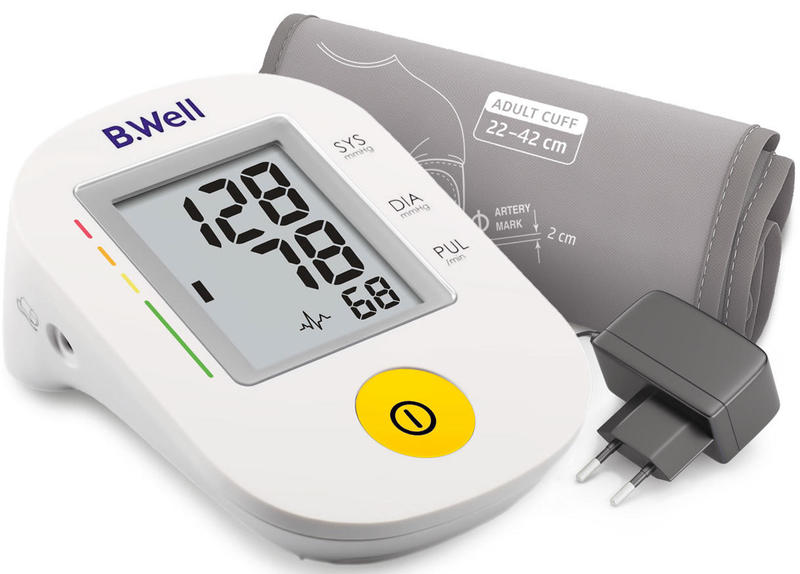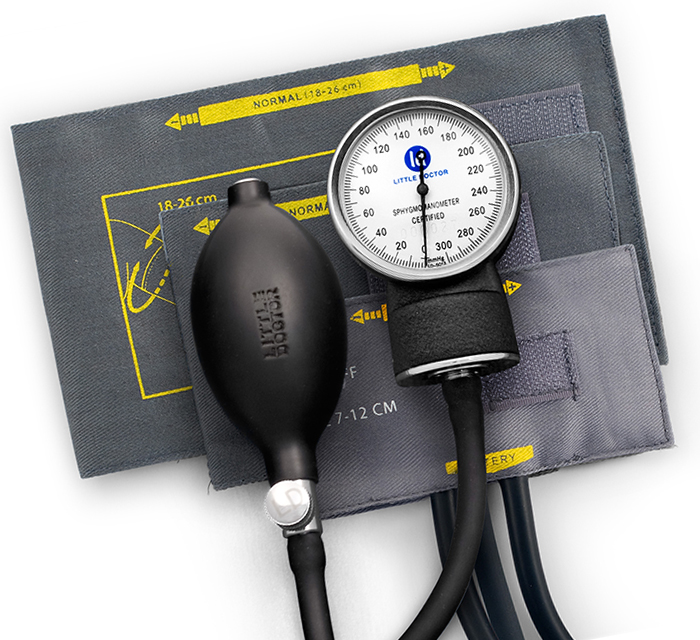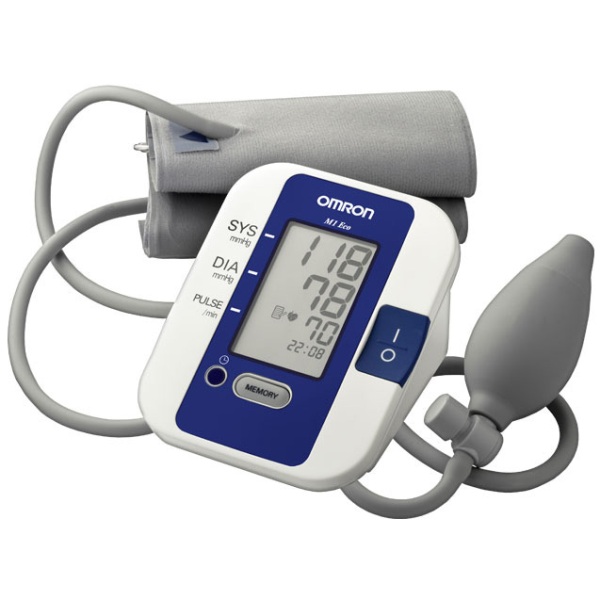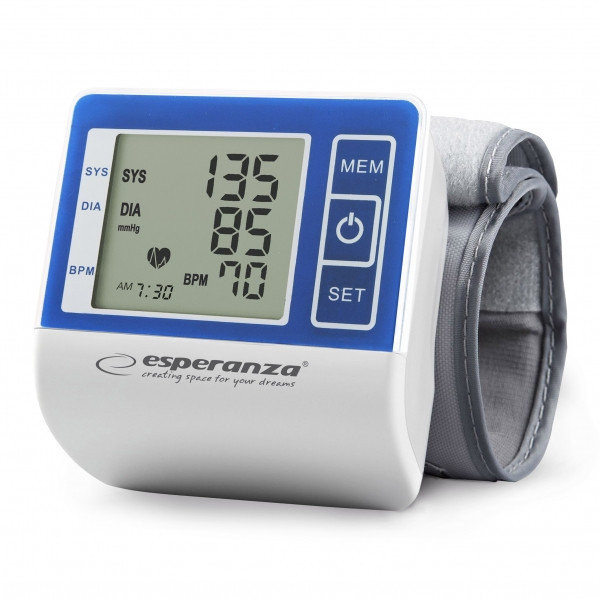The tonometer will never be superfluous in the house. Pressure problems can occur completely unexpectedly at any age. A medical device will allow you to independently measure blood pressure at home. How to choose a tonometer among all variety of models? After all, I want it to be not only high-quality, but also convenient in unprofessional use. Our experts will tell you all about these devices and the criteria for the right choice.

Content
Types of tonometers and principle of operation
Blood pressure meters vary in type, design, size. To choose a suitable device, you need to familiarize yourself with the principle of operation of the device.
The principle of operation of tonometers
The tonometer, regardless of its type, consists of three main parts:
- Cuffs worn on the shoulder / wrist / finger.
- Air pumping systems.
- Pressure gauge / display with numbers.
In mechanical models there is a stethoscope.
The cuff has a pneumatic chamber inside. It is pumped up by air. In this case, the arteries are compressed, the blood flow is blocked. At this moment, nothing is heard through a stethoscope (if a mechanical tonometer is used), since blood does not circulate. After opening the valve, the air of their pneumatic chamber leaves, blood flow resumes and heart beats are clearly audible through a stethoscope.
The number on the scale on which the first strokes were recorded, registers the upper (systolic) blood pressure. When the strokes completely stop, this means that the blood flow is restored and lower (diastolic) blood pressure is recorded on this figure.
In order to obtain an accurate result in a mechanical tonometer, it is necessary to bleed air slowly.
In automatic devices, everything is simpler - the device pumps and releases air independently. A person does not need to listen and record the beat of the heart. The tonometer will detect the numbers and show them on the display.
Classification of tonometers by type
The first blood pressure monitor was created in 1881 by an Austrian specialist. It was bulky and complicated. It used a mercury manometer. Later, the Russian surgeon N. S. Korotkov invented a device that allows you to measure pressure by listening and measuring systolic and diastolic tones. It was a lighter mechanical device. Such tonometers have been in use for many years and still exist. Later, electronic models began to replace them.
We will get acquainted with all types of tonometers and understand their device in more detail.
Mechanical (manual)

The device consists of:
- shoulder cuffs;
- pears through which air is pumped;
- a stethoscope to listen to;
- measuring scale (manometer).
The mechanical tonometer device involves manually injecting air. In this case, the measuring one should listen to the noise through a stethoscope and at the same time observe the manometer. This will require some dexterity. Not everyone can measure pressure right the first time. In addition, it will be difficult for a person to do this on their own.
To this day, doctors in clinics use these tonometers. Despite some shortcomings, the model remains the most accurate in terms of results in comparison with more modern products.
Pros:
- High degree of reliability, wear resistance.
- The exact result.
- No electricity, batteries.
- If you accidentally move your hands, the results are not distorted.
- Low price.
Minuses:
- To obtain accurate results, the ability to use such a device is required.
- Does not show heart rate.
- People with hearing loss will not be able to measure pressure on their own, as it requires wiretapping of noise.
- It will be difficult for a person in serious condition to independently pump air.
Semi-automatic

The device is a combination of mechanical and electronic elements. There is no stethoscope, which greatly facilitates the operation. Instead of a mechanical monometer, he has an electronic display on which indicators are displayed. The cuff is worn on the shoulder. The device can be used both by doctors in polyclinics and by ordinary users at home.
The user must manually pump air into the cuff, the rest happens automatically. The display shows numbers with blood pressure indicators and heart rate.
Pros:
- It does not require special knowledge and skills.
- Measures not only pressure, but also pulse.
- It has a fairly high accuracy.
- People with hearing problems can use it.
Minuses:
- Batteries or mains required.
- Higher price.
The semi-automatic type pressure measuring device is so simple to operate that anyone can figure it out the first time.
Auto

Automatic blood pressure monitor is fully electronic. Such devices can have a regular cuff, worn on the upper part of the arm, a wrist or finger retainer. Devices vary in size. Almost all models also have a heart rate indicator and auto memory function. Some devices are equipped with additional options.
The air in them is pumped with a compressor. All that is needed to start the electronic tonometer is to press the start button. The indicators are displayed.
Electronic tonometers, despite their convenience, are not used in the professional field. They have a major flaw - they can distort the results. In the medical field this is unacceptable. Whatever the result is smeared, you cannot move during pressure measurement.
For home use, such models are optimal.
Pros:
- Easy to operate.
- High accuracy of readings (if measured according to instructions).
- Lack of a stethoscope.
- There is a memory, you can compare the results.
- It does not require any skills from the user.
- Suitable for people with low vision and hearing.
Minuses:
- Requires batteries, battery charging, or a network connection.
- Not recommended for people with severe cardiovascular disorders.
- High cost.
Among electronic blood pressure monitors, there are more "sophisticated" models, with arrhythmia indicators, motion sensors, automatic calculation of the average after several measurements and even advisers. If a person has problems with pressure, the device advises him to urgently consult a doctor.
Distinction between carpal and shoulder tonometer
Cuffs made of nylon fabric. On a hand they are fixed by means of a fastener flypaper. The device is connected to the cuff air chamber using a rubber tube. Shoulder cuff sizes are standard on most models. But there are children's tonometers with a smaller cuff in size and volume.
The shoulder brace can have both mechanical and electronic devices. This type of cuff is considered the best. It most accurately determines the patient's condition and pressure indicators.
Tonometers for the wrist are only electronic. The device body is attached directly to the cuff, which is also pumped with air through the compressor. The device is fixed with Velcro.

Such a device is not very accurate and is not recommended for people suffering from serious diseases.It is more suitable for athletes who control their pulse and blood pressure during training, people suffering from minor disorders of the cardiovascular system. Also, the device can distort the results if the user has tremor of his hands or there is sclerosis of the vessels.
An arterial blood pressure monitor put on a finger is not considered a serious medical device at all. One can hardly hope for reliable results of measuring blood pressure by such a device.
How to choose
Let's consider how to choose a tonometer for independent home use, depending on its classification and technical parameters.
Criteria for choosing a mechanical tonometer
The mechanical type of device is suitable for people over 40 years old, and especially the elderly. At this age, many begin atherosclerotic changes in the vessels and become less pronounced in the area of the radial artery. A manual blood pressure monitor allows you to more accurately record the results, since the actions can be adjusted manually.
Some mechanical models are offered an age set of cuffs. The older the person, the wider and denser the cuff is needed.
When choosing a mechanical tonometer, the following factors are taken into account:
- Pressure gauge quality. In cheap models, it can be made of plastic. But it is better to buy a device with a metal pressure gauge.
- The quality of the rubber of which the pear and tube are made. Hard material will crack quickly.
- Cuff material and density. Thin rag cuffs wear out quickly. The material should not stretch. Ideally, it should be tight nylon. You should also pay attention to Velcro. The bigger it is, the better.
- Measuring range. Most mechanical devices have an upper parameter of 0-300, and a lower +/- 3 mm Hg.
- Equipment. If the device is bought for the whole family, then you should choose a model with a set of cuffs. The presence of a cover will improve the storage conditions of the device.
- Instruction To learn how to use a mechanical tonometer on your own, you need to read the instructions and follow it.
- Warranty from the manufacturer. Verified brands give a minimum of 1 year warranty.
Hand tonometers from Japanese, Swiss, German manufacturers are considered the most reliable.
How to choose a semi-automatic blood pressure monitor
When buying a semi-automatic blood pressure monitor, it is important to pay attention to the following criteria:
- The quality of the case. It is important that the plastic is tight, all parts tightly fastened.
- Display. Before buying, be sure to check the screen and make sure it is working properly.
- Serviceability of all buttons. They must be checked by turning on the device.
- Cuff material and size. As well as in mechanical tonometers, in electronic cuffs should be dense and nylon with a wide Velcro-retainer.
- Quality rubber tube and pear. Here the same rules - the more elastic the rubber, the more it will serve.
Please note that a good semi-automatic blood pressure monitor cannot be cheap.
Automatic tonometer selection
In order to choose a high-quality automatic blood pressure monitor, in addition to the parameters of the case, cuff and hose, it is necessary to pay attention to additional functions and evaluate their need. Indeed, the price depends on the number of options.
Modern high-tech electronic devices can be equipped with:
- A memory capacity capable of storing from 3-4 to 200 measurements.
- Intelligent control, reducing errors and the likelihood of erroneous results in cardiac arrhythmias.
- Diagnosis of arrhythmia, with information displayed on the screen.
- Enlarged numbers and letters (for poorly seeing people).
- Voice scoring indicators.
- Color indicators (each color means the norm or the degree of deviation from it).
- Automatic triple metering and calculation of the average indicator (option allows you to most accurately determine the result).
General tips for choosing a tonometer for the home
You need to select a pressure meter, taking into account other nuances of a personal nature:
- Estimated frequency of use.Automatic models are more suitable for frequent use.
- Cuff size. People can be very fat or thin. It is important to immediately see how the cuff "sits" on the arm and make sure that the size fits.
- Age of patients. Older people can accurately measure blood pressure only with the shoulder cuff. Young people can choose a tonometer with a cuff on the wrist.
- The presence of cardiovascular pathologies. If any, the device with the smart metering function will be relevant.
- The need for pulse measurement. Only semi-automatic machines and automatic machines have this option.
- The convenience of use. Here, of course, the leading position is occupied by electronic automatic models.
What type of tonometer is better to buy for home use
Experts recommend buying automatic or semi-automatic devices with a cuff on the shoulder for independent measurement of blood pressure. Such models are suitable for several family members of different age categories. In addition, such devices are designed for frequent use.
The brand of the manufacturer is of great importance. This is a serious medical device that measures very important vital signs. Therefore, it is very important not to save on buying a tonometer and choose models only from trusted brands.
Top tonometer manufacturers
- Omron
- Microlife
- Nissei
- CS Helthcare
- Beurer
- Withings
- AND UA
The heart is the most important organ and without it our life is impossible. If for some reason you need to monitor your pressure and pulse, do not save and be sure to buy a good tonometer. Now you know how to choose it.